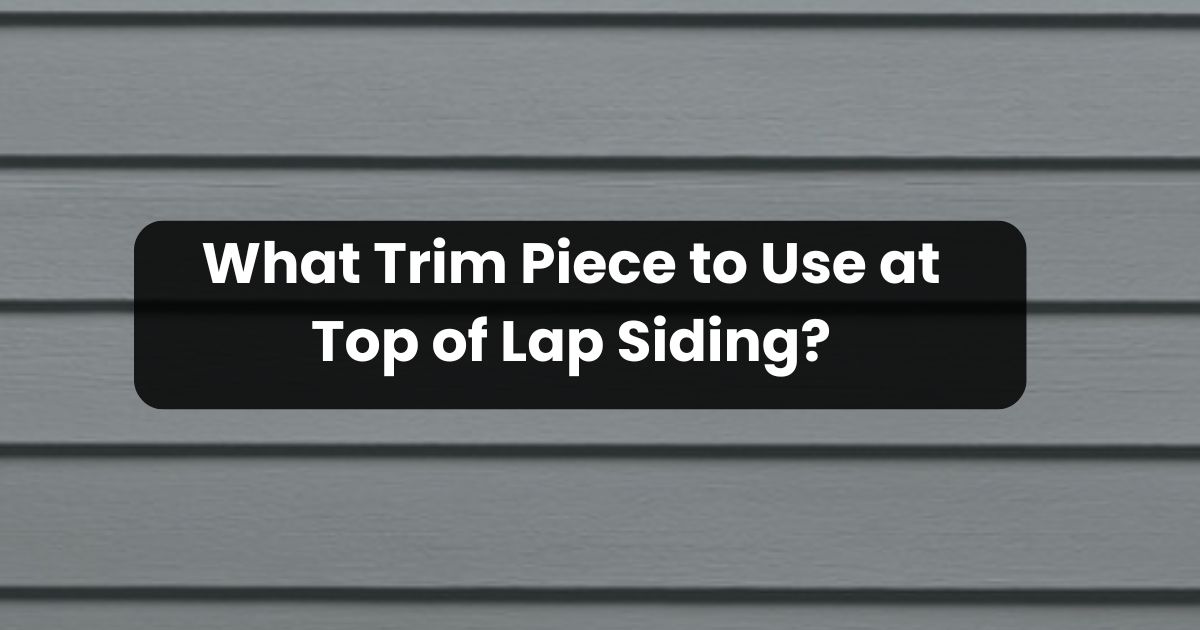A Contractor’s Complete Guide
As a contractor with extensive experience, I’ll walk you through everything you need to know about selecting and installing the right trim piece for the top of your lap siding. This comprehensive guide covers material choices, installation techniques, and pro tips to ensure your siding trim lasts for years to come.
Let me tell you why I’m such a big fan of installing trim over siding rather than under it. The traditional way – putting trim first and butting siding against it – seems logical at first. But here’s the thing: that caulk line between them? It’s going to fail. Every house settles, materials expand and contract with the seasons, and before you know it, you’re getting calls about water damage.
Here’s how I do it instead:
First, let’s talk prep work. If you’re working with new construction or adding exterior sheeting, don’t skimp on the house wrap. It’s your first line of defense against moisture. Make sure you fold it carefully around corners and seams – water’s sneaky, and it’ll find any weak spot.
When installing the siding, I run it all the way to the edges. Don’t cut it short! You want a solid base for your trim. Work your way up from the bottom, letting each piece overlap naturally to create that crucial drainage plane.
Now for the trim itself. I typically use PVC, vinyl, or fiber cement, depending on the project and budget. Whatever you choose, secure it directly over the siding every 12-16 inches with corrosion-resistant fasteners. This creates a rock-solid installation that won’t need constant maintenance.
Here’s a real-world situation I ran into recently: I had a garage door frame that stuck out further than the new exterior sheeting. Instead of panicking, I adapted by cutting custom trim pieces to match the frame’s depth. It looked great and maintained the home’s character while providing proper protection.
Should Trim Be Installed On Top Of Siding?
Listen up – after years of field experience, I’ve seen the good, the bad, and the ugly when it comes to trim installation. Let’s cut through the noise and talk about why installing trim over siding is a game-changer for long-term performance.
The Over vs. Under Debate
Here’s the deal – traditional methods tell you to install trim first, then butt your siding against it with a little caulk in between. Sure, it looks great on day one. But here’s what I’ve seen time and time again: that caulk line becomes your worst enemy. As the house settles and materials move with the seasons, that caulk cracks, water finds its way in, and guess who gets the callback?
So here’s what I do instead – I flip the script. By installing trim over the siding, we completely eliminate the need for caulk. Let me break down why this method is superior:
- No More Weak Spots You won’t have any caulk lines to crack or peel. It’s that simple.
- Rock-Solid Structure The trim actually helps anchor your siding firmly to the wall. No more gaps or loose boards.
- Clean, Professional Look This method creates smooth, uninterrupted lines that enhance your home’s curb appeal and maintain its architectural integrity.
My Step-by-Step Installation Process
1. Getting the Base Right
First things first – if we’re dealing with exterior sheeting (plywood or OSB), I always start with a proper house wrap installation. This isn’t just another layer; it’s your home’s shield against moisture. I take extra time to wrap those corners and seams properly because that’s where water loves to sneak in.
2. Siding Installation: The Foundation for Success
Here’s a key tip: install your lap siding horizontally, working bottom to top. Each board should overlap the one below it – that’s your natural drainage plane right there. When you hit corners or openings, don’t cut the siding short. Run it right to the edge. This gives you a solid foundation for your trim and eliminates those vulnerable gaps that can cause problems down the road.
3. Securing the Trim: The Final Touch
Once your siding’s in place, it’s time for the trim. I typically use PVC, vinyl, or fiber cement trim – each has its place depending on your situation. Here’s the crucial part: secure that trim every 12-16 inches with corrosion-resistant fasteners. Make sure it sits flush against the siding.
Pro Tip: Don’t skimp on the fasteners. I’ve seen plenty of jobs fail because someone tried to save a few bucks on nails. Use quality, corrosion-resistant fasteners that won’t rust out on you.
Let’s talk materials. Each type of trim has its sweet spot:
- Vinyl trim works great with vinyl siding and won’t break the bank
- Fiber cement is my go-to for high-end projects, especially with Hardie siding
- PVC is perfect for coastal areas where moisture resistance is crucial
| Material | Pros | Cons | Best For |
|---|---|---|---|
| Vinyl | Affordable, low maintenance | Can warp in extreme heat | Window trim for vinyl siding |
| Fiber Cement | Fireproof, durable | Heavy, requires professional install | Hardie siding corner trim |
| Aluminum | Rust-proof, sleek finish | Dents easily | Modern romes |
| Wood | Natural aesthetic | High maintenance (rot, pests) | House exterior corner trim |
One thing I’ve learned the hard way: always plan for movement. Use ring-shank nails that allow for slight flexibility, and angle your trim downward just a touch (1-2 degrees) to encourage water runoff. These small details make a huge difference in the long run.
What I love about this method is how versatile it is. Whether you’re working on a modern farmhouse with crisp white trim against dark siding, or a classic Craftsman with wide window frames, this technique adapts beautifully.
Remember: no caulk means no callbacks. By installing trim over siding, you’re not just making things look good – you’re building something that’ll last. As someone who takes pride in their work, that’s what matters most to me.
Best Trim Pieces for Top of Lap Siding
From my years in the field, here are the top options for your lap siding trim:
J-Channel Trim
If you’re working with vinyl siding, J-channel trim is often your best bet for the top of lap siding. It creates a clean, professional finish and effectively manages water runoff.
F-Channel Trim
Perfect for transitions between lap siding and soffit areas, F-channel trim provides excellent coverage and protection at the top of your lap siding installation.
Fiber Cement Trim
Board When working with Hardie or other fiber cement siding, a matching fiber cement trim board offers durability and seamless integration at the top of your lap siding.
Expert Tips for Top of Lap Siding Trim
- Always measure twice, cut once
- Pre-paint trim pieces before installation when possible
- Keep expansion gaps consistent
- Use proper tools for clean cuts
- Consider local building codes when selecting materials
Got questions about your specific project?
Choosing the right trim piece for the top of your lap siding is crucial for both aesthetics and protection. The key is selecting materials that complement your siding while providing adequate protection from the elements. Remember, proper installation is just as important as material selection.
Need more specific advice for your project? Feel free to ask – I’ve handled countless siding installations and can help you choose the perfect trim solution for your situation.
Also read
Dutch Lap Siding vs. Traditional Siding
The Most Cost-Effective House Siding Options for 2025
FAQs
Can I install trim over existing siding?
Yes! Use furring strips to create a flat surface for installing exterior window trim over siding.
What’s the best trim for corners?
For outside corners, miter the trim pieces at 45 degrees for a professional finish. For inside corners, you can either miter them or use a cope joint. Always leave proper expansion gaps based on your trim material and climate.
What trim piece goes at the top of vinyl lap siding?
For vinyl lap siding, J-channel or F-channel trim pieces are the most common and effective choices. J-channel provides a clean finish and proper water management, while F-channel works best when transitioning to soffit areas. Both options are designed specifically for vinyl siding systems.
Should I install trim over or under lap siding?
I always recommend installing trim over lap siding rather than under it. This method eliminates the need for caulking, prevents water infiltration, and provides better long-term durability. It also creates a cleaner, more professional appearance and requires less maintenance over time.
How long should top trim for lap siding last?
With proper installation and maintenance:
- Vinyl trim: 20-30 years
- PVC trim: 25-30 years
- Fiber cement trim: 30-50 years Actual lifespan depends on climate, exposure, and maintenance.
How do you finish the top of Hardie lap siding?
For Hardie lap siding, use fiber cement trim boards specifically designed for James Hardie products. Install the trim over the top course of siding, securing it with corrosion-resistant nails every 12-16 inches. Ensure the trim has a slight downward angle for proper water drainage.




